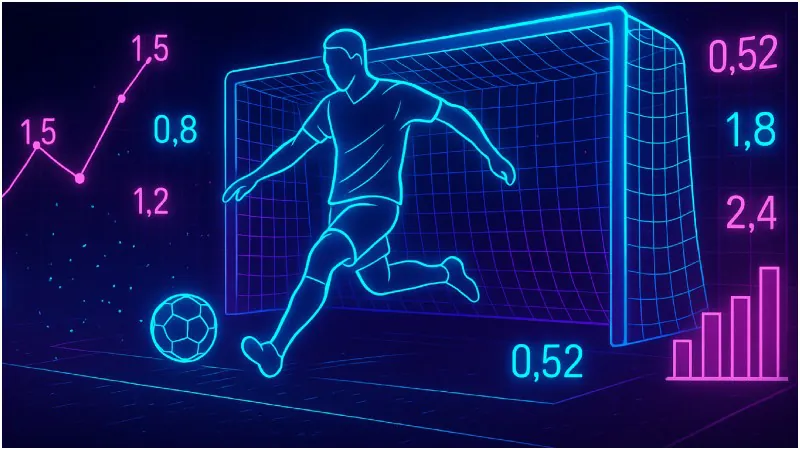
Football in 2025 is more data-driven than ever. Advanced statistics such as Expected Goals (xG), Expected Assists (xA), ball possession, passing accuracy, and conversion rates allow fans, analysts, and bettors to move beyond simple scorelines. These metrics highlight performance quality, efficiency, and mistakes, giving a more complete view of how matches are won or lost.
Introduction: Why Advanced Stats Matter in 2025
In the modern game, football analysis is no longer just about goals and possession. Advanced statistics provide deeper insights into team efficiency, player contributions, and tactical execution. Clubs, coaches, and even fans rely on these numbers to evaluate performance and predict future outcomes with greater accuracy.
By 2025, metrics like xG, xA, and defensive error counts have become standard references across leagues worldwide. Understanding these stats helps fans interpret games more effectively and allows bettors to make smarter predictions.
Expected Goals (xG) and Expected Assists (xA)
Perhaps the most influential metrics in modern football, xG and xA measure the quality of chances created and converted, not just the number of shots or passes.
What is xG?
- Expected Goals (xG) calculates the likelihood of a shot resulting in a goal.
- Factors include shot distance, angle, body part used, and defensive pressure.
- Example: A penalty kick typically carries an xG of 0.76 (76% chance of scoring).
Why xG Matters:
- Shows whether a team created quality chances or relied on low-probability attempts.
- Explains why teams with fewer shots may still dominate games if their chances were stronger.
- Helps evaluate whether a result was deserved or a product of luck.
What is xA?
- Expected Assists (xA) measures the probability that a pass will lead to a goal-scoring chance.
- Values increase for key passes into dangerous areas.
- Example: A perfectly weighted through ball has higher xA than a simple side pass.
Why xA Matters:
- Highlights creative players who may not always show up on the scoresheet.
- Differentiates between volume passers and those who consistently create dangerous opportunities.
Together, xG and xA reveal whether a team’s attacking output is sustainable or inflated by luck.
Ball Possession & Passing Accuracy
Possession has always been a popular stat, but in 2025, it is combined with passing accuracy to give more meaningful context.
Key Insights:
- Possession Percentage: Reflects control of the game but not necessarily dominance.
- Passing Accuracy: Shows efficiency in ball circulation and buildup.
- Progressive Passing: Focuses on forward movement rather than safe sideways passes.
Why It Matters:
- A team with high possession but low accuracy often struggles to convert control into chances.
- Clubs with balanced possession and precise passing typically dominate midfield battles.
- Passing accuracy highlights player reliability, especially midfielders and defenders under pressure.
Example: Team A may record 65% possession but only 78% passing accuracy, showing wasted control. Meanwhile, Team B with 45% possession and 90% accuracy might generate more effective attacks.
Shots on Target, Conversion Rate, and Defensive Errors
While possession and xG show how opportunities are created, shots on target, conversion rate, and defensive mistakes reveal how efficiently those opportunities are used—or wasted.
Shots on Target
- Measures the number of attempts that actually test the goalkeeper.
- More shots on target usually indicate attacking pressure, but quality matters more than quantity.
- Example: 10 total shots with 2 on target shows inefficiency, while 5 shots with 4 on target reflects clinical play.
Conversion Rate
- Calculated by dividing goals scored by total shots.
- High conversion rate = clinical finishing, often linked to elite strikers.
- Low conversion rate = poor shot selection or lack of composure.
Defensive Errors
- Tracks mistakes that lead directly to shots or goals.
- Includes misjudged clearances, poor back-passes, or failed marking.
- One defensive error can undo 90 minutes of control.
Together, these three stats highlight the fine margins of winning and losing. A team may dominate possession but still fall short if conversion rates are low or defensive errors are costly.
Bringing It All Together
The strength of advanced statistics lies in combination analysis. No single stat tells the whole story.
- xG + Conversion Rate: Shows whether a team is underperforming or overperforming expected numbers.
- Possession + Passing Accuracy: Reveals if control leads to meaningful opportunities.
- Defensive Errors + Shots on Target: Explains how mistakes translate into goals conceded.
By using these metrics together, fans, analysts, and bettors can form well-rounded conclusions rather than relying on surface-level stats.
Why xG Matters in 2025
- Helps analysts judge whether a team created quality chances rather than relying on low-probability shots.
- Provides context beyond raw shot numbers—20 weak attempts may be less valuable than 5 high-quality ones.
- Assists bettors and coaches in evaluating whether results were deserved or influenced by luck.
- Paired with conversion rates, xG shows if teams are finishing efficiently or underperforming.
What is xG (Expected Goals)?
xG, or Expected Goals, is an advanced football statistic that measures the probability of a shot resulting in a goal. Each attempt is assigned a value between 0 and 1 based on factors such as:
- Shot Distance: Closer attempts have higher chances of scoring.
- Angle to Goal: Central positions are more favorable than wide angles.
- Body Part Used: Headers generally carry lower xG than shots with feet.
- Defensive Pressure: Shots under heavy marking have reduced xG.
Example:
- A penalty kick typically has an xG of 0.76, meaning it is expected to result in a goal 76% of the time.
- A long-range effort outside the box might carry only 0.05 xG, or a 5% chance.Frequently Asked Questions (FAQ)
1. What is the most reliable advanced stat in football?
Expected Goals (xG) is considered the most insightful, as it evaluates the quality of chances rather than raw shot counts.
2. Do possession stats guarantee a team’s dominance?
Not necessarily. Possession without accuracy or creativity often results in sterile control with limited goal threat.
3. How do defensive errors impact analysis?
They often explain unexpected results, such as a dominant team losing due to one or two costly mistakes.
4. Are advanced stats useful for betting predictions?
Yes. Metrics like xG, conversion rate, and recent defensive records provide deeper context for outcome predictions.
5. Can casual fans understand these stats easily?
Absolutely. Many modern apps simplify advanced stats into visuals like heatmaps and dashboards, making them easy to follow.
Conclusion: The Future of Football Analysis in 2025
UFABET แทงบอล เว็บตรง ยูฟ่าเบท แทงบอลออนไลน์ Advanced football statistics have revolutionized how matches are understood. Metrics such as xG, xA, possession, passing accuracy, and conversion rates go beyond surface results, offering detailed insights into team efficiency and weaknesses.
In 2025, the combination of these stats enables fans, experts, and bettors to interpret games more accurately, predict outcomes smarter, and appreciate football at a deeper level. For anyone looking to analyze matches effectively, mastering these advanced metrics is no longer optional—it’s essential.
crifosports/31August25/SA





























